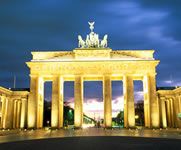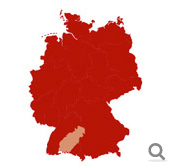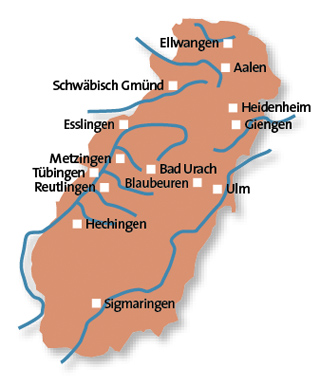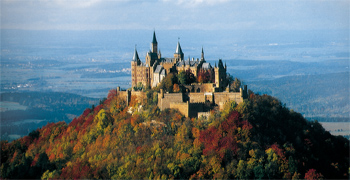
Historical Towns
- Historical towns in Brandenburg
- Cathedral Towns and Cities in Saxony-Anhalt
- The innovative Anhalt-Wittenberg Region
- Enchanting towns in the Harz
- The beautiful towns and cities in Saxony
- Towns and cities of culture in Thuringia
- Beautiful towns of Franconia
- East Bavarian traditional towns
- Alpine towns in the Allg�u
- The eastern Akpine Foothills and their towns
- Towns and villages in the western foothills of the Alps
- Mediterranean towns on Lake Constance
- Towns in the Swabian Alb
- Unspoilt towns in the Black Forest
- Towns for refined tastes in the Heilbronner Land
- Towns in the Odenwald
- Wine towns in Rheinhessen
- Saarland, a region of contrasts
- Romantic towns in the Hunsr�ck and Nahe Regions
- Idyllic towns and villages in the Moselle Region
- The Ahr Rhine Eifel holiday region
- Wine towns on the Romantic Rhine
- Modern towns and cities in the Bergisches Land Region
- The Lahn Valley and its fairytale towns
- Historical towns in Kurhessisches Bergland
- Sauerland's scenic towns
- Fairytale towns in the Weserbergland Hills
- Majestic towns in the M�nsterland Region
- The nine stars of Lower Saxony
- North and East Frisian Islands
- Vibrant Schleswig-Holstein
- Maritime towns along Mecklenburg's Baltic Coast
- Historical Hanseatic Towns
- Germany's Baltic Sea Islands
- The Mecklenburg Lakes
Contact and information
Emperors and Nobel Prize winners relaxation on the banks of the Neckar river

Hohenzollern Castle
Hohenzollern Castle is the ancestral seat of one of Germany's most illustrious imperial dynasties. The original castle was probably built as long ago as the 11th century. Still held in the treasure chamber are the Prussian king's crown and other memorabilia relating to Frederick the Great. Hohenzollern Castle is one of the most visited castles in Europe. An extensive private collection of medieval arms and armour is on display at the Hohenzollern palace in Sigmaringen.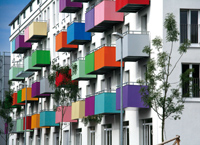
University town of Tübingen
Pope Benedict XVI or Professor Joseph Ratzinger, as he was at the time taught for four years at Tübingen's Eberhard Karls University, where he was Professor of Catholic Dogma until 1969. Tübingen is an old town with a young feel. Its most photographed sight is probably the Neptune fountain in front of the town hall, whose tower is graced by an astronomical clock. This was designed by Johannes Stöffler almost 500 years ago and even shows solar and lunar eclipses. A good place to sit and admire his mechanical masterpiece is the Pfuderer Café, formerly the home of the poet Isolde Kurz.In the summer, there's revelry on the River Neckar with a traditional punt race that is both a contest and a massive party. Tübingen is an excellent base for a variety of walks, for example in the Schönbuch nature reserve or to Lichtenstein Castle, a fairytale Württemberg fortress perched above the Echaz valley. Other towns such as Reutlingen, Heidenheim, Aalen and Ellwangen have castles, palaces and abbeys to visit too, or you can browse and shop to your heart's delight. St. John's Church and the Holy Cross Minster in Schwäbisch Gmünd are also well worth seeing. If it's fashion you're after, you must make a detour to Metzingen, where the factory outlets offer international designer labels at knock-down prices.
Bad Urach
Ever since permission was granted for the first shepherds' guild race in 1723, the Schäferlauf has been held in Bad Urach every other year. It is now a traditional Swabian festival that gets underway to the sound of trumpets. The mayor then calls for the dancing to begin and the spectacle eventually culminates in a grand festival procession. One regular feature is a performance of D'Schäferlies, a play written specially for the event. The Schäferlauf is not only an established folk custom but also an opportunity for today's working shepherds and their dogs to demonstrate their skills in the sheepdog trials. Other highlights in Bad Urach are the magnificent palace in the historical quarter and the ruins of Hohenurach Castle above the old town. Your reward for walking up to the castle is a breathtaking view of the Urach waterfall gushing from a height of 37 metres.Swabian Alb Geopark
Astounding excavated fossils, Jurassic sea reefs, volcanic craters, meteorite impacts, caves, karst springs and dramatic rock formations: the Swabian Alb Geopark will show you how to interpret the traces left behind as the Earth has developed over millions of years. The archaeological finds include the oldest known Stone Age artworks and musical instruments as well as pieces of Celtic jewellery. As an extended plateau in the heart of the European Jura mountains, the Swabian Alb has an exceptionally high number of caves. So far, more than two thousand have been discovered and the most interesting are open to visitors.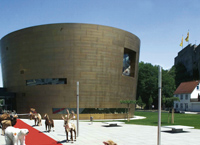
Einstein and company
Albert Einstein formulated his theory of relativity in Berlin, but he was born in Ulm so his theory can be regarded as an expression of Swabian genius. Other famous Swabians include Gottlieb Daimler, the automobile engineer, and Max Eyth, chief engineer to the Egyptian Prince Halim Pasha. Another successful figure from the Swabian Alb was Margarethe Steiff, whose cuddly toy company invented the teddy bear in 1902.Swabian Alb à la carte
The Swabian Alb is Germany's egg noodle and pasta capital. Two local specialities are spätzle noodles and maultaschen ravioli. So the story goes, the latter originally served as a way for cooks to side-step fasting rules by hiding meat inside small pasta parcels. Pretzels were invented in the Swabian Alb in the 15th century, when Count Eberhart the Bearded, the first Duke of Württemberg, requested a pastry through which the sun could shine through three times. When you get thirsty, you can enjoy a great local beer along with the locals. Or if you prefer a drop of bubbly, visit Germany's oldest sekt producer in Esslingen.Travel Planner
Select an option...
Romance and charm
There is something magical about the Blautopf pool in Blaubeuren, a place of many myths and legends. One of the most charming tales is of a mermaid who learned to laugh again at its turquoise waters. She is still said to appear fleetingly in the watery depths now and again.
Food and drink
The water buffalo herds near Ödenwaldstetten are one of the Swabian Alb's latest attractions. Not only are these very impressive animals, they're also the source of unusual meat and dairy products such as Albzarella, a cheese made from Alb buffalo milk.
History and tradition
The Swabian Alb has one of the highest concentrations of castles and palaces in Germany, a total of almost 400. They represent many different eras and over 100 are well preserved. Ruins and true fairytale castles are among the highlights.
Nature and scenery
On three certified premium-grade trails you can discover the natural and man-made features of the Swabian Alb as you delve deep into mysteries and tales about its geology, flora and fauna, settlement history and archaeology.




